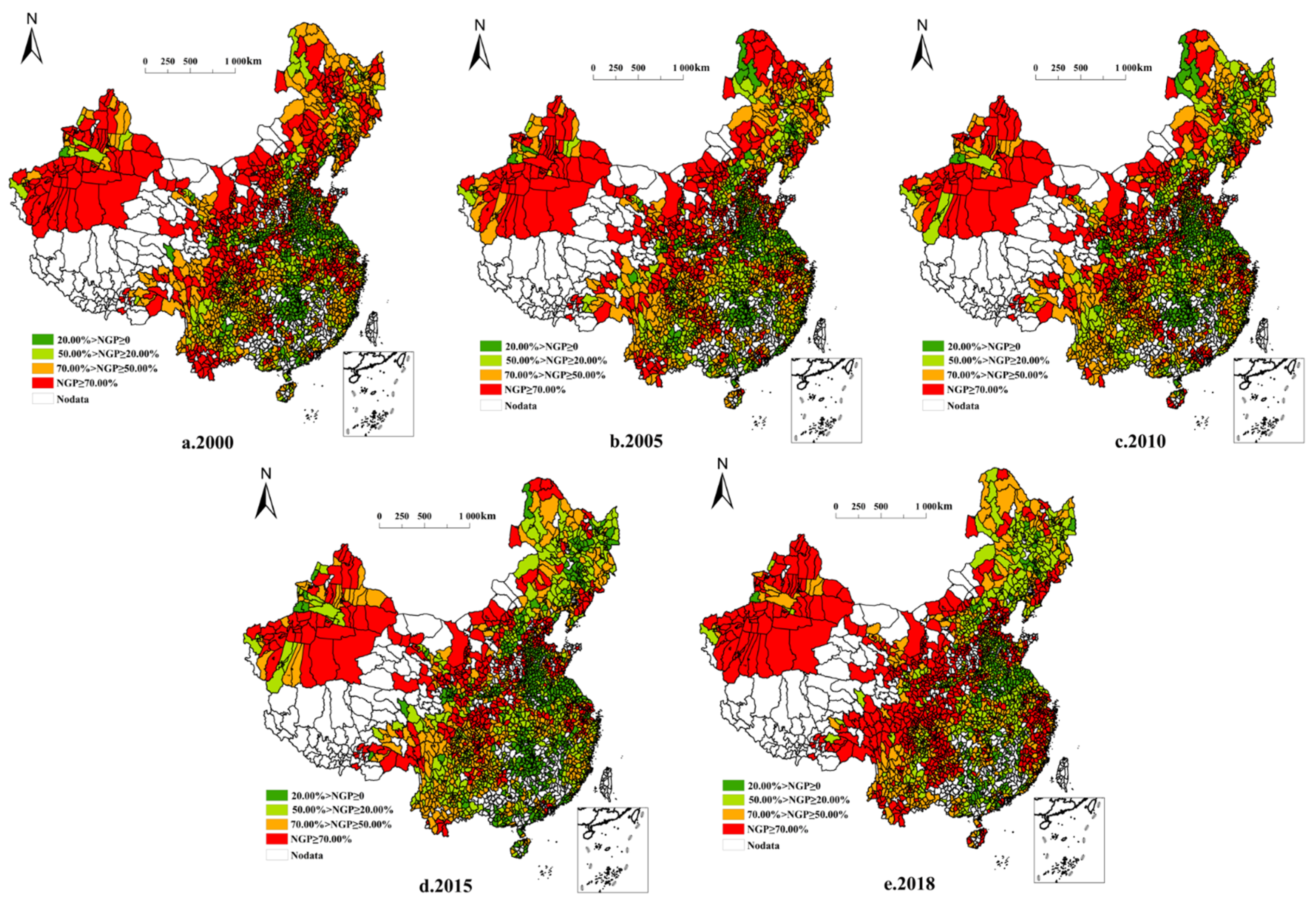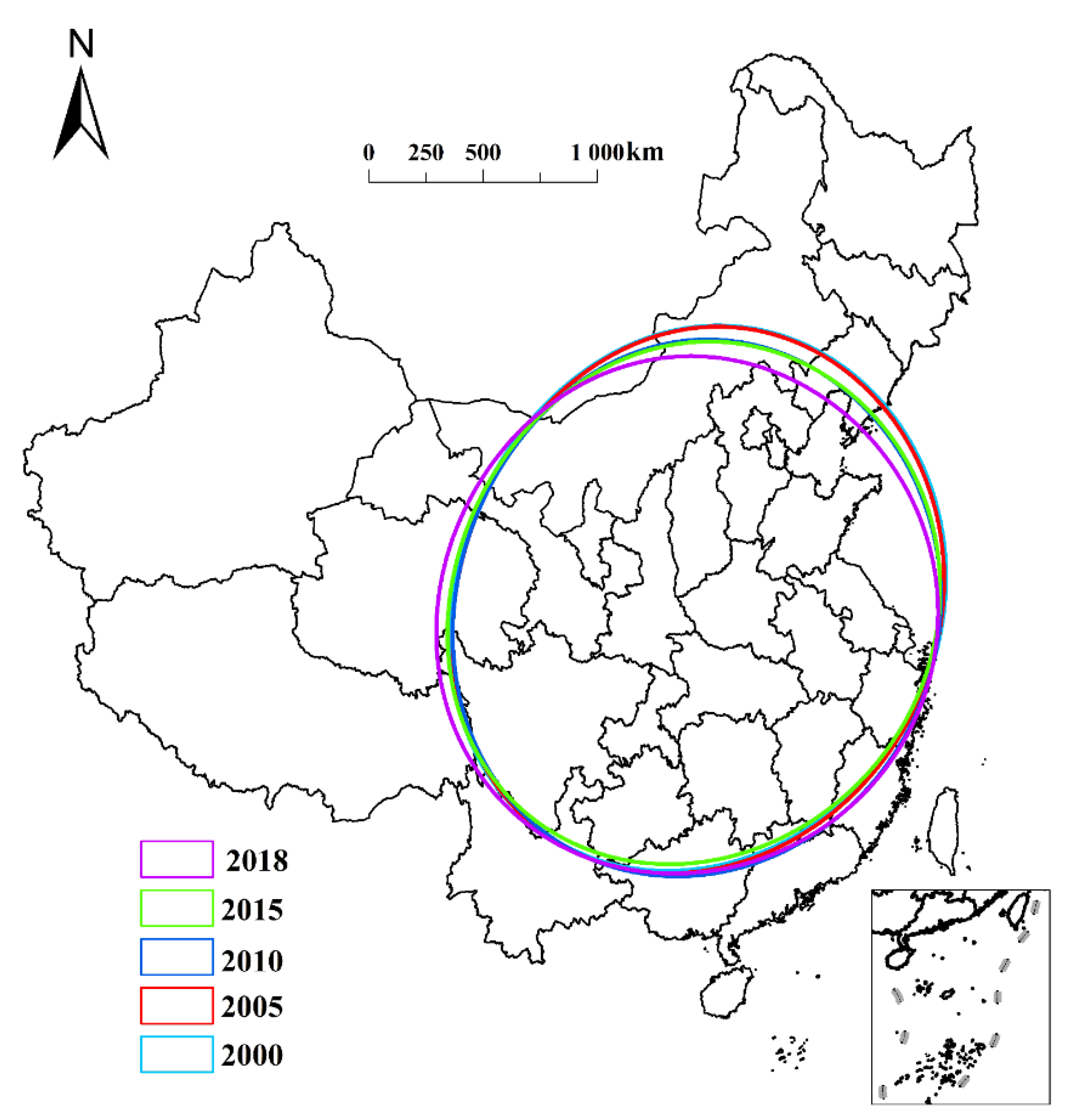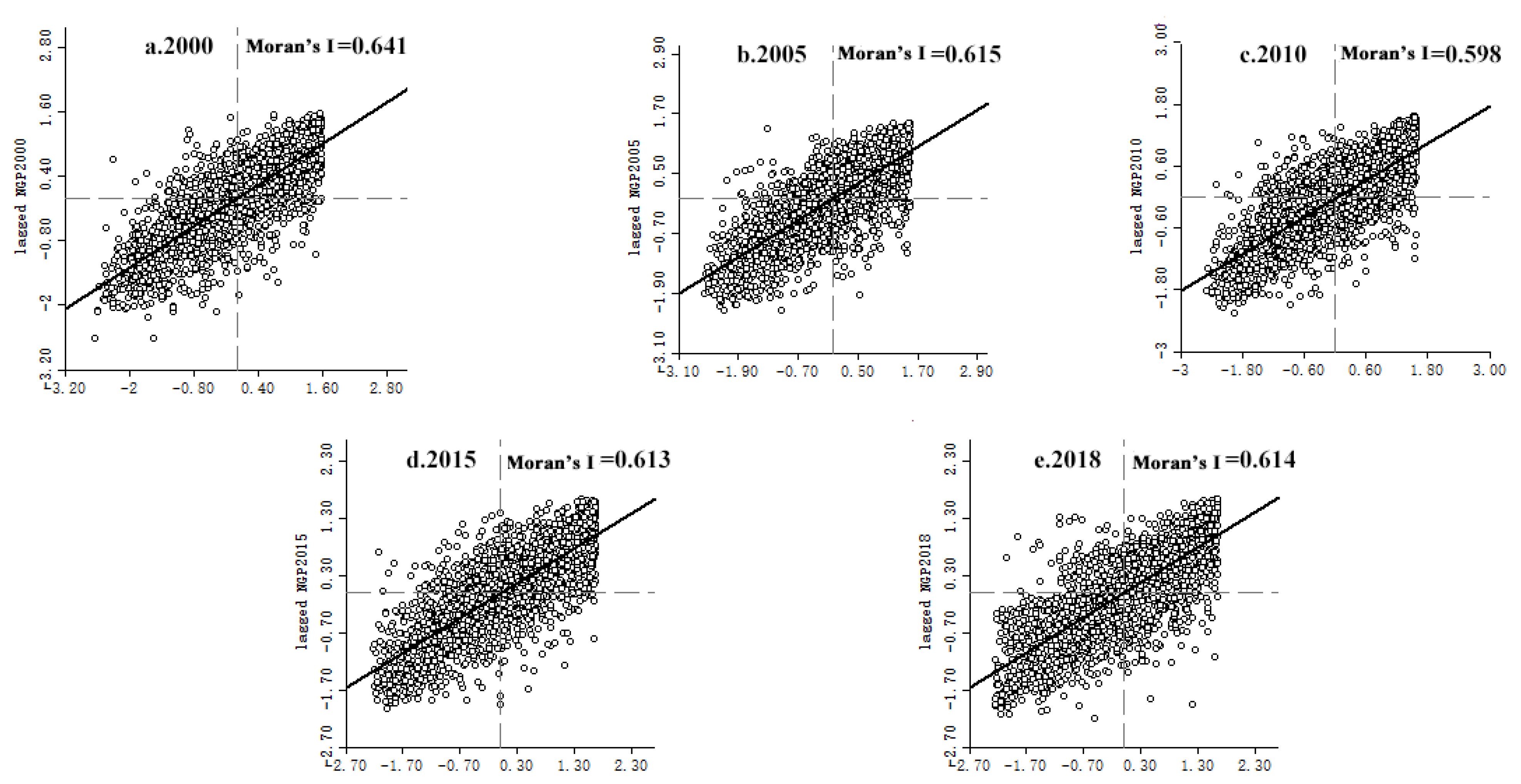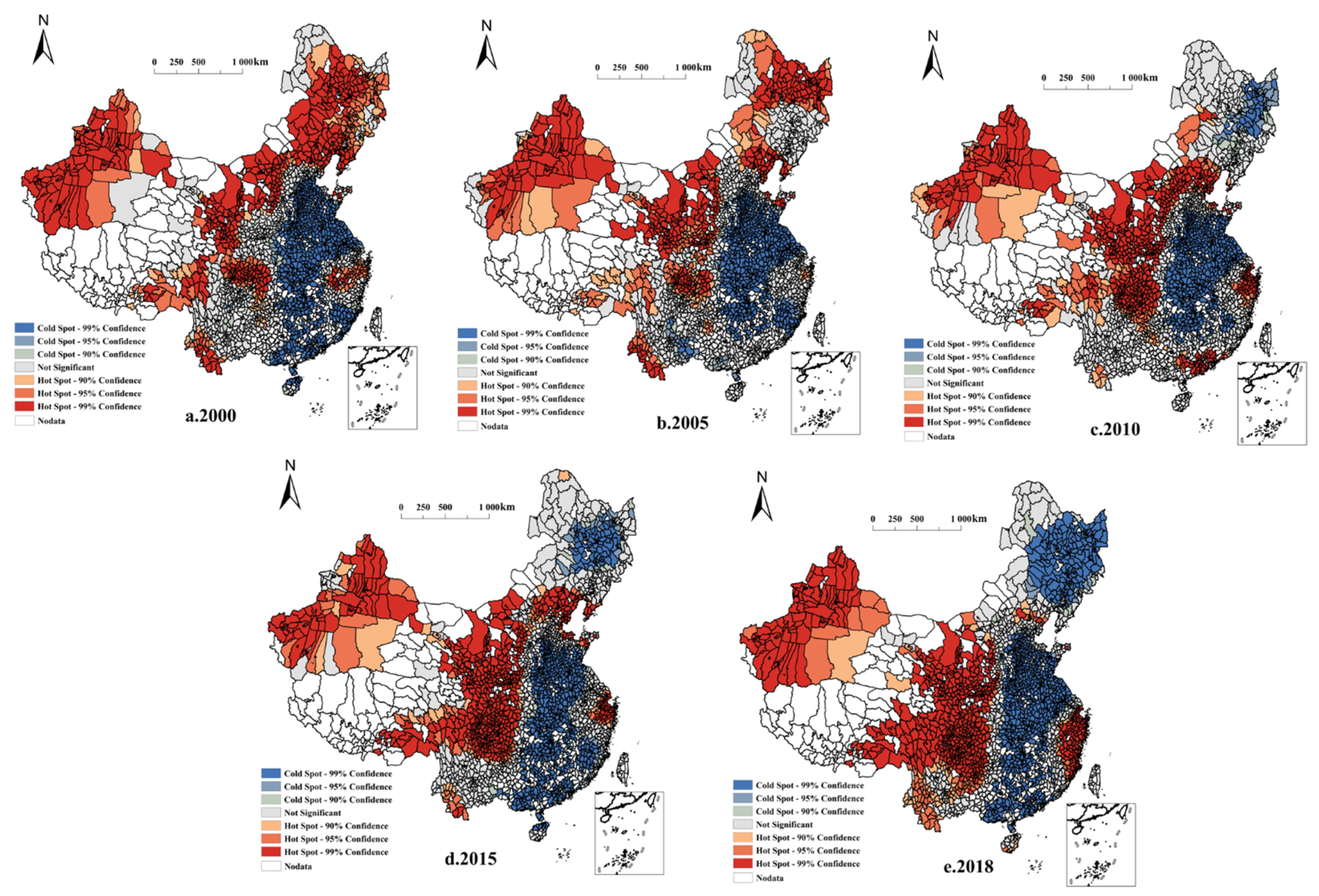Spatiotemporal Evolution of Non-Grain Production of Cultivated Land and Its Underlying Factors in China
Abstract
:1. Introduction
2. Materials and Methods
2.1. Study Area and Data Acquisition
2.2. Methodology
2.2.1. Exploratory Spatial Data Analysis
2.2.2. Geographic Detector (GeoDetector) Model
2.3. Variable Description
2.3.1. NGPR Measurement
2.3.2. Driving Factor Determination
3. Results
3.1. NGPR Measurement and Regional Characteristics
3.1.1. Overall and Regional Characteristics
3.1.2. NGPR Spatial Variability Patterns
3.2. Spatial Correlation and Differentiation Patterns of the NGPR
3.2.1. Global Spatial Correlation Characteristics
3.2.2. Local Spatial Differentiation Patterns
3.3. Factor Identification of NGPR Spatial Differentiation
3.3.1. Identifying Dominant Factors
3.3.2. Interaction between Factors
4. Discussion
4.1. Impact of NGP on Food Security
4.2. Drivers of NGP
4.3. NGP Control Measures
5. Conclusions
Author Contributions
Funding
Institutional Review Board Statement
Informed Consent Statement
Data Availability Statement
Conflicts of Interest
References
- Newbold, T.; Hudson, L.N.; Hill, S.L.; Contu, S.; Lysenko, I.; Senior, R.A.; Borger, L.; Bennett, D.J.; Choimes, A.; Collen, B.; et al. Global effects of land use on local terrestrial biodiversity. Nature 2015, 520, 45–50. [Google Scholar] [CrossRef] [PubMed] [Green Version]
- Li, C.; Wu, J. Land use transformation and eco-environmental effects based on production-living-ecological spatial synergy: Evidence from Shaanxi Province, China. Environ. Sci. Pollut. Res. 2022, 29, 41492–41504. [Google Scholar] [CrossRef]
- Li, Y.; Li, Y.; Westlund, H.; Liu, Y. Urban-rural transformation in relation to cultivated land conversion in China: Implications for optimizing land use and balanced regional development. Land Use Policy 2015, 47, 218–224. [Google Scholar] [CrossRef]
- Liang, X.; Guan, Q.; Clarke, K.C.; Liu, S.; Wang, B.; Yao, Y. Understanding the drivers of sustainable land expansion using a patch-generating land use simulation (PLUS) model: A case study in Wuhan, China. Comput. Environ. Urban Syst. 2020, 85, 101569. [Google Scholar] [CrossRef]
- Liang, X.; Jin, X.; Yang, X.; Xu, W.; Lin, J.; Zhou, Y. Exploring cultivated land evolution in mountainous areas of Southwest China, an empirical study of developments since the 1980s. Land Degrad. Dev. 2021, 32, 546–558. [Google Scholar] [CrossRef]
- Su, Y.; Li, C.L.; Wang, K.; Deng, J.S.; Shahtahmassebi, A.R.; Zhang, L.P.; Ao, W.J.; Guan, T.; Pan, Y.; Gan, M.Y. Quantifying the spatiotemporal dynamics and multi-aspect performance of non-grain production during 2000–2015 at a fine scale. Ecol. Indic. 2019, 101, 410–419. [Google Scholar] [CrossRef]
- Su, Y.; Qian, K.; Lin, L.; Wang, K.; Guan, T.; Gan, M. Identifying the driving forces of non-grain production expansion in rural China and its implications for policies on cultivated land protection. Land Use Policy 2020, 92, 104435. [Google Scholar] [CrossRef]
- Luo, Y.; Zhang, Z.; Li, Z.; Chen, Y.; Zhang, L.; Cao, J.; Tao, F. Identifying the spatiotemporal changes of annual harvesting areas for three staple crops in China by integrating multi-data sources. Environ. Res. Lett. 2020, 15, 074003. [Google Scholar] [CrossRef]
- Liu, X.; Zheng, J.; Yu, L.; Hao, P.; Chen, B.; Xin, Q.; Fu, H.; Gong, P. Annual dynamic dataset of global cropping intensity from 2001 to 2019. Sci. Data 2021, 8, 283. [Google Scholar] [CrossRef]
- Ye, X.Y.; Rey, S. A framework for exploratory space-time analysis of economic data. Ann. Reg. Sci. 2013, 50, 315–339. [Google Scholar] [CrossRef]
- Pan, J.W.; Chen, Y.Y.; Zhang, Y.; Chen, M.; Fennell, S.; Luan, B.; Wang, F.; Meng, D.; Liu, Y.L.; Jiao, L.M.; et al. Spatial-temporal dynamics of grain yield and the potential driving factors at the county level in China. J. Clean. Prod. 2020, 255, 120312. [Google Scholar] [CrossRef]
- Zhang, Y.; Liu, Y.; Zhang, Y.; Liu, Y.; Zhang, G.; Chen, Y. On the spatial relationship between ecosystem services and urbanization: A case study in Wuhan, China. Sci. Total Environ. 2018, 637, 780–790. [Google Scholar] [CrossRef] [PubMed]
- Wang, J.F.; Li, X.H.; Christakos, G.; Liao, Y.L.; Zhang, T.; Gu, X.; Zheng, X.Y. Geographical Detectors-Based Health Risk Assessment and its Application in the Neural Tube Defects Study of the Heshun Region, China. Int. J. Geogr. Inf. Sci. 2010, 24, 107–127. [Google Scholar] [CrossRef]
- Wang, J.-F.; Zhang, T.-L.; Fu, B.-J. A measure of spatial stratified heterogeneity. Ecol. Indic. 2016, 67, 250–256. [Google Scholar] [CrossRef]
- Chen, L.; Song, G.; Meadows, M.E.; Zou, C. Spatio-temporal evolution of the early-warning status of cultivated land and its driving factors: A case study of Heilongjiang Province, China. Land Use Policy 2018, 72, 280–292. [Google Scholar] [CrossRef]
- Liu, X.; Zhao, C.; Song, W. Review of the evolution of cultivated land protection policies in the period following China′s reform and liberalization. Land Use Policy 2017, 67, 660–669. [Google Scholar] [CrossRef]
- Qu, Y.; Jiang, G.-h.; Li, Z.; Tian, Y.; Wei, S. Understanding rural land use transition and regional consolidation implications in China. Land Use Policy 2019, 82, 742–753. [Google Scholar] [CrossRef]
- Bickenbach, F.; Bode, E.; Nunnenkamp, P.; Soder, M. Night lights and regional GDP. Rev. World Econ. 2016, 152, 425–447. [Google Scholar] [CrossRef] [Green Version]
- Levin, N.; Kyba, C.C.M.; Zhang, Q.L.; de Miguel, A.S.; Roman, M.O.; Li, X.; Portnov, B.A.; Molthan, A.L.; Jechow, A.; Miller, S.D.; et al. Remote sensing of night lights: A review and an outlook for the future. Remote Sens. Environ. 2019, 237, 111443. [Google Scholar] [CrossRef]
- Zhou, Y.; Li, X.H.; Liu, Y.S. Rural land system reforms in China: History, issues, measures and prospects. Land Use Policy 2019, 91, 104330. [Google Scholar] [CrossRef]
- Barrera, E.L.; Hertel, T. Global food waste across the income spectrum: Implications for food prices, production and resource use. Food Policy 2020, 98, 101874. [Google Scholar] [CrossRef]
- Deng, X.; Xu, D.D.; Zeng, M.; Qi, Y.B. Does Internet use help reduce rural cropland abandonment? Evidence from China. Land Use Policy 2019, 89, 104243. [Google Scholar] [CrossRef]
- Deng, X.Z.; Gibson, J. Improving eco-efficiency for the sustainable agricultural production: A case study in Shandong, China. Technol. Forecast. Soc. Chang. 2019, 144, 394–400. [Google Scholar] [CrossRef]
- Fitton, N.; Alexander, P.; Arnell, N.; Bajzelj, B.; Calvin, K.; Doelman, J.; Gerber, J.S.; Havlik, P.; Hasegawa, T.; Herrero, M.; et al. The vulnerabilities of agricultural land and food production to future water scarcity. Glob. Environ. Chang.-Hum. Policy Dimens. 2019, 58, 101944. [Google Scholar] [CrossRef]
- Ge, D.Z.; Long, H.L.; Zhang, Y.G.; Ma, L.; Li, T.T. Farmland transition and its influences on grain production in China. Land Use Policy 2018, 70, 94–105. [Google Scholar] [CrossRef]
- Ma, L.; Long, H.L.; Tu, S.S.; Zhang, Y.N.; Zheng, Y.H. Farmland transition in China and its policy implications. Land Use Policy 2020, 92, 104470. [Google Scholar] [CrossRef]
- Kang, L.; Zhao, R.; Wu, K.N.; Huang, Q.; Zhang, S.C. Impacts of Farming Layer Constructions on Cultivated Land Quality under the Cultivated Land Balance Policy. Agronomy 2021, 11, 2403. [Google Scholar] [CrossRef]
- Li, L.Y.; Li, T.S. Improvement Measurement to Guarantee the Quantity and Quality of Ecological Cultivated Land. Ekoloji 2019, 28, 1835–1845. [Google Scholar]
- Liu, L.M.; Zhou, D.; Chang, X.; Lin, Z.L. A new grading system for evaluating China′s cultivated land quality. Land Degrad. Dev. 2020, 31, 1482–1501. [Google Scholar] [CrossRef]
- Sheng, Y.; Liu, W.Z.; Xu, H.L.; Gao, X.C. The Spatial Distribution Characteristics of the Cultivated Land Quality in the Diluvial Fan Terrain of the Arid Region: A Case Study of Jimsar County, Xinjiang, China. Land 2021, 10, 896. [Google Scholar] [CrossRef]
- Song, W.; Zhang, H.Z.; Zhao, R.; Wu, K.N.; Li, X.J.; Niu, B.B.; Li, J.Y. Study on cultivated land quality evaluation from the perspective of farmland ecosystems. Ecol. Indic. 2022, 139, 108959. [Google Scholar] [CrossRef]
- Tan, Y.Z.; Chen, H.; Lian, K.; Yu, Z.N. Comprehensive Evaluation of Cultivated Land Quality at County Scale: A Case Study of Shengzhou, Zhejiang Province, China. Int. J. Environ. Res. Public Health 2020, 17, 1169. [Google Scholar] [CrossRef] [PubMed] [Green Version]
- Chen, C.; Pang, Y.M. Response of maize yield to climate change in Sichuan province, China. Glob. Ecol. Conserv. 2019, 22, e00893. [Google Scholar] [CrossRef]
- Chu, Z.D.; Ming, B.; Li, L.L.; Xue, J.; Zhang, W.X.; Hou, L.Y.; Xie, R.Z.; Hou, P.; Wang, K.R.; Li, S.K. Dynamics of maize grain drying in the high latitude region of Northeast China. J. Integr. Agric. 2022, 21, 365–374. [Google Scholar] [CrossRef]
- Duan, B.; Fang, S.H.; Gong, Y.; Peng, Y.; Wu, X.T.; Zhu, R.S. Remote estimation of grain yield based on UAV data in different rice cultivars under contrasting climatic zone. Field Crops Res. 2021, 267, 108148. [Google Scholar] [CrossRef]
- Hou, P.; Liu, Y.E.; Liu, W.M.; Yang, H.S.; Xie, R.Z.; Wang, K.R.; Ming, B.; Liu, G.Z.; Xue, J.; Wang, Y.H.; et al. Quantifying maize grain yield losses caused by climate change based on extensive field data across China. Resour. Conserv. Recycl. 2021, 174, 105811. [Google Scholar] [CrossRef]
- Liu, M.; Guo, Y.; Wang, Y.F.; Hao, J. Changes of Extreme Agro-Climatic Droughts and Their Impacts on Grain Yields in Rain-Fed Agricultural Regions in China over the Past 50 Years. Atmosphere 2021, 13, 4. [Google Scholar] [CrossRef]
- Niu, Y.N.; Xie, G.D.; Xiao, Y.; Liu, J.Y.; Wang, Y.Y.; Luo, Q.; Zou, H.X.; Gan, S.; Qin, K.Y.; Huang, M.D. Spatiotemporal Patterns and Determinants of Grain Self-Sufficiency in China. Foods 2021, 10, 747. [Google Scholar] [CrossRef] [PubMed]
- Sun, M.Y.; Chou, J.M.; Xu, Y.; Yang, F.; Li, J.N. Study on the thresholds of grain production risk from climate change in China′s main grain-producing areas. Phys. Chem. Earth 2020, 116, 102837. [Google Scholar] [CrossRef]
- Sun, Z.Q.; Hu, R.F.; Hong, Y. Does yield gap still matter? Evidence from rice production in China. Food Secur. 2022, 14, 829–840. [Google Scholar] [CrossRef]
- Wang, D.Y.; Li, X.Y.; Ye, C.; Xu, C.M.; Chen, S.; Chu, G.; Zhang, Y.B.; Zhang, X.F. Geographic variation in the yield formation of single-season high-yielding hybrid rice in southern China. J. Integr. Agric. 2021, 20, 438–449. [Google Scholar] [CrossRef]
- Xue, L.Z.; Khan, S.B.; Sun, M.; Anwar, S.; Ren, A.X.; Gao, Z.A.; Lin, W.; Xue, J.F.; Yang, Z.P.; Deng, Y. Effects of tillage practices on water consumption and grain yield of dryland winter wheat under different precipitation distribution in the loess plateau of China. Soil Tillage Res. 2019, 191, 66–74. [Google Scholar] [CrossRef]
- Yan, Y.Y.; Hou, P.; Duan, F.Y.; Niu, L.; Dai, T.B.; Wang, K.R.; Zhao, M.; Li, S.K.; Zhou, W.B. Improving photosynthesis to increase grain yield potential: An analysis of maize hybrids released in different years in China. Photosynth. Res. 2021, 150, 295–311. [Google Scholar] [CrossRef] [PubMed]
- Zhang, H.; Tao, F.L.; Zhou, G.S. Potential yields, yield gaps, and optimal agronomic management practices for rice production systems in different regions of China. Agric. Syst. 2019, 171, 100–112. [Google Scholar] [CrossRef]
- Tan, S.K.; Liu, Q.; Han, S.Y. Spatial-temporal evolution of coupling relationship between land development intensity and resources environment carrying capacity in China. J. Environ. Manag. 2021, 301, 113778. [Google Scholar] [CrossRef]
- Zhang, M.Y.; Chen, Q.X.; Zhang, K.W. Influence of the variation in rural population on farmland preservation in the rapid urbanization area of China. J. Geogr. Sci. 2021, 31, 1365–1380. [Google Scholar] [CrossRef]
- Zhang, R.T.; Lu, J.F. Simulation of Land Use Pattern Evolution from a Multi-Scenario Perspective: A Case Study of Suzhou City in Anhui Province, China. Int. J. Environ. Res. Public Health 2021, 18, 921. [Google Scholar] [CrossRef]
- Zhou, Y.; Li, X.H.; Liu, Y.S. Cultivated land protection and rational use in China. Land Use Policy 2021, 106, 105454. [Google Scholar] [CrossRef]
- Zhuang, Q.W.; Shao, Z.F.; Huang, X.; Zhang, Y.; Wu, W.F.; Feng, X.X.; Lv, X.W.; Ding, Q.; Cai, B.W.; Altan, O. Evolution of soil salinization under the background of landscape patterns in the irrigated northern slopes of Tianshan Mountains, Xinjiang, China. Catena 2021, 206, 105561. [Google Scholar] [CrossRef]
- Gong, Y.L.; Li, J.T.; Li, Y.X. Spatiotemporal characteristics and driving mechanisms of arable land in the Beijing-Tianjin-Hebei region during 1990-2015. Socio-Economic Plan. Sci. 2019, 70, 100720. [Google Scholar] [CrossRef]
- Liu, Y.X.; Liu, S.L.; Sun, Y.X.; Wang, F.F.; Li, M.Q. Driving forces of cultivated land evolution in agro-pastoral areas on the Qinghai-Tibet Plateau based on ecological niche theory. J. Clean. Prod. 2021, 313, 127899. [Google Scholar] [CrossRef]
- Lu, X.H.; Zhang, Y.W.; Zou, Y.C. Evaluation the effect of cultivated land protection policies based on the cloud model: A case study of Xingning, China. Ecol. Indic. 2021, 131, 108247. [Google Scholar] [CrossRef]
- Qian, F.K.; Chi, Y.R.; Lal, R. Spatiotemporal characteristics analysis of multifunctional cultivated land: A case-study in Shenyang, Northeast China. Land Degrad. Dev. 2020, 31, 1812–1822. [Google Scholar] [CrossRef]
- Wang, Q.; Li, Y.B.; Luo, G.J. Spatiotemporal change characteristics and driving mechanism of slope cultivated land transition in karst trough valley area of Guizhou Province, China. Environ. Earth Sci. 2020, 79, 1–18. [Google Scholar] [CrossRef]
- Zhou, L.; Dang, X.W.; Sun, Q.K.; Wang, S.H. Multi-scenario simulation of urban land change in Shanghai by random forest and CA-Markov model. Sustain. Cities Soc. 2020, 55, 102045. [Google Scholar] [CrossRef]
- Caldwell, W.; Epp, S.; Wan, X.Y.; Singer, R.; Drake, E.; Sousa, E.C. Farmland Preservation and Urban Expansion: Case Study of Southern Ontario, Canada. Front. Sustain. Food Syst. 2022, 6, 777816. [Google Scholar] [CrossRef]
- Chen, H.; Meng, F.; Yu, Z.N.; Tan, Y.Z. Spatial-temporal characteristics and influencing factors of farmland expansion in different agricultural regions of Heilongjiang Province, China. Land Use Policy 2022, 115, 106007. [Google Scholar] [CrossRef]
- Han, A.T.; Daniels, T.L.; Kim, C. Managing urban growth in the wake of climate change: Revisiting greenbelt policy in the US. Land Use Policy 2021, 112, 105867. [Google Scholar] [CrossRef]
- Liang, X.Y.; Jin, X.B.; Han, B.; Sun, R.; Xu, W.Y.; Li, H.B.; He, J.; Li, J. China′s food security situation and key questions in the new era: A perspective of farmland protection. J. Geogr. Sci. 2022, 32, 1001–1019. [Google Scholar] [CrossRef]
- Liu, J.; Jin, X.B.; Xu, W.Y.; Zhou, Y.K. Evolution of cultivated land fragmentation and its driving mechanism in rural development: A case study of Jiangsu Province. J. Rural Stud. 2022, 91, 58–72. [Google Scholar] [CrossRef]
- Liu, Z. Rural Population Decline, Cultivated Land Expansion, and the Role of Land Transfers in the Farming-Pastoral Ecotone: A Case Study of Taibus, China. Land 2022, 11, 256. [Google Scholar] [CrossRef]
- Lu, S.H.; Wang, H. Limited Decentralization: Understand China′s Land System from the Perspective of Central-Local Relation. Land 2022, 11, 517. [Google Scholar] [CrossRef]
- Yang, X.; Sang, Y.M.; Zhang, A.L. How livelihood capital affects farmers′ willingness to pay for farmland non-market value? Evidence from Jianghan Plain, China. Environ. Sci. Pollut. Res. 2022, 1–13. [Google Scholar] [CrossRef]
- Zhang, L.; Lin, X.H.; Qiu, B.K.; Ou, G.L.; Zhang, Z.; Han, S.Y. Impact of Value Perception on Farmers′ Willingness to Participate in Farmland Fallow: A Case-Study in Major Grain-Producing Areas of Hubei and Hunan, China. Sustainability 2022, 14, 724. [Google Scholar] [CrossRef]
- Zhang, R.Q.; Li, P.H.; Xu, L.P.; Zhong, S.; Wei, H. An integrated accounting system of quantity, quality and value for assessing cultivated land resource assets: A case study in Xinjiang, China. Glob. Ecol. Conserv. 2022, 36, e02115. [Google Scholar] [CrossRef]
- Zhou, T.X.; Tan, R.; Shu, X.F. Rigidity with partial elasticity: Local government adaptation under the centralized land quota system in China. Land Use Policy 2022, 118, 106138. [Google Scholar] [CrossRef]





| Judgment Basis | Interaction | Code |
|---|---|---|
| q(X1∩X2) < min(q(X1), q(X2)) | Nonlinear Weaken | NW |
| min(q(X1), q(X2)) < q(X1∩X2) < max(q(X1), q(X2)) | Univariate Nonlinear Weaken | UNW |
| q(X1∩X2) > max(q(X1), q(X2)) | Bivariate Enhance | BE |
| q(X1∩X2) = q(X1) + q(X2) | Independent | IN |
| q(X1∩X2) > q(X1) + q(X2) | Nonlinear Enhance | NE |
| Index | Code | Resolution | Data Sources | |
|---|---|---|---|---|
| Weather factors | Average annual precipitation | X1 | 0.1° × 0.1° | University of East Anglia Institute |
| Average annual temperature | X2 | 0.1° × 0.1° | University of East Anglia Institute | |
| Topography | Elevation | X3 | 30 m | Shuttle Radar Topography Mission |
| Slope | X4 | 30 m | Shuttle Radar Topography Mission | |
| Soil factors | Soil carbon content | X5 | 1 km | Harmonized World Soil Database |
| Soil organic matter | X6 | 1 km | Harmonized World Soil Database | |
| Socioeconomic factors | Population density | X7 | 100 m | United Nations Population Density Data |
| Night light data | X8 | 1 km | NPP/VIIRS night lighting products | |
| Distance from highway | X9 | / | National Basic Geographic Information Center | |
| Distance from railway | X10 | / | National Basic Geographic Information Center | |
| Distance from capital city | X11 | / | National Basic Geographic Information Center |
| 2000 | 2005 | 2010 | 2015 | 2018 | |
|---|---|---|---|---|---|
| Moran′s I | 0.310 | 0.274 | 0.271 | 0.254 | 0.325 |
| Z | 90.882 | 80.496 | 79.650 | 74.671 | 95.314 |
| Factor | 2000 | 2005 | 2010 | 2015 | 2018 | |||||
|---|---|---|---|---|---|---|---|---|---|---|
| q | Rank | q | Rank | q | Rank | q | Rank | q | Rank | |
| X1 | 0.128 | 3 | 0.100 | 3 | 0.086 | 2 | 0.072 | 3 | 0.062 | 5 |
| X2 | 0.172 | 1 | 0.164 | 1 | 0.127 | 1 | 0.130 | 1 | 0.108 | 2 |
| X3 | 0.137 | 2 | 0.116 | 2 | 0.078 | 4 | 0.064 | 4 | 0.087 | 3 |
| X4 | 0.030 | 8 | 0.034 | 7 | 0.027 | 8 | 0.041 | 5 | 0.035 | 8 |
| X5 | 0.105 | 4 | 0.089 | 4 | 0.081 | 3 | 0.096 | 2 | 0.132 | 1 |
| X6 | 0.030 | 9 | 0.026 | 9 | 0.031 | 5 | 0.027 | 7 | 0.019 | 10 |
| X7 | 0.025 | 10 | 0.021 | 11 | 0.011 | 11 | 0.023 | 9 | 0.012 | 11 |
| X8 | 0.047 | 5 | 0.030 | 8 | 0.028 | 6 | 0.029 | 6 | 0.068 | 4 |
| X9 | 0.046 | 6 | 0.047 | 5 | 0.028 | 7 | 0.026 | 8 | 0.053 | 6 |
| X10 | 0.023 | 11 | 0.023 | 10 | 0.014 | 10 | 0.016 | 11 | 0.035 | 7 |
| X11 | 0.045 | 7 | 0.036 | 6 | 0.026 | 9 | 0.018 | 10 | 0.022 | 9 |
| Factor Interaction | 2000 | 2005 | 2010 | 2015 | 2018 | |||||
|---|---|---|---|---|---|---|---|---|---|---|
| q | Type | q | Type | q | Type | q | Type | q | Type | |
| X1∩X2 | 0.221 | BE | 0.180 | BE | 0.189 | BE | 0.185 | BE | 0.143 | BE |
| X1∩X3 | 0.217 | BE | 0.195 | BE | 0.148 | BE | 0.124 | BE | 0.174 | NE |
| X1∩X5 | 0.198 | BE | 0.157 | BE | 0.149 | BE | 0.127 | BE | 0.185 | BE |
| X1∩X8 | 0.224 | NE | 0.172 | NE | 0.160 | NE | 0.123 | NE | 0.172 | NE |
| X1∩X9 | 0.162 | NE | 0.137 | BE | 0.109 | BE | 0.088 | BE | 0.111 | BE |
| X2∩X3 | 0.243 | BE | 0.234 | BE | 0.189 | BE | 0.185 | BE | 0.192 | BE |
| X2∩X5 | 0.224 | BE | 0.209 | BE | 0.189 | BE | 0.184 | BE | 0.201 | BE |
| X2∩X8 | 0.232 | NE | 0.211 | NE | 0.174 | NE | 0.169 | NE | 0.190 | NE |
| X2∩X9 | 0.183 | NE | 0.191 | NE | 0.147 | BE | 0.144 | BE | 0.150 | BE |
| X3∩X5 | 0.163 | BE | 0.139 | BE | 0.125 | BE | 0.134 | BE | 0.175 | BE |
| X3∩X8 | 0.170 | NE | 0.143 | BE | 0.101 | BE | 0.096 | NE | 0.132 | BE |
| X3∩X9 | 0.142 | NE | 0.123 | NE | 0.085 | BE | 0.068 | BE | 0.102 | BE |
| X5∩X8 | 0.131 | BE | 0.105 | BE | 0.109 | BE | 0.121 | BE | 0.161 | BE |
| X5∩X9 | 0.116 | NE | 0.115 | BE | 0.093 | BE | 0.105 | BE | 0.145 | BE |
| X8∩X9 | 0.091 | BE | 0.079 | NE | 0.058 | NE | 0.057 | NE | 0.104 | BE |
Publisher’s Note: MDPI stays neutral with regard to jurisdictional claims in published maps and institutional affiliations. |
© 2022 by the authors. Licensee MDPI, Basel, Switzerland. This article is an open access article distributed under the terms and conditions of the Creative Commons Attribution (CC BY) license (https://creativecommons.org/licenses/by/4.0/).
Share and Cite
Zhu, Z.; Dai, Z.; Li, S.; Feng, Y. Spatiotemporal Evolution of Non-Grain Production of Cultivated Land and Its Underlying Factors in China. Int. J. Environ. Res. Public Health 2022, 19, 8210. https://doi.org/10.3390/ijerph19138210
Zhu Z, Dai Z, Li S, Feng Y. Spatiotemporal Evolution of Non-Grain Production of Cultivated Land and Its Underlying Factors in China. International Journal of Environmental Research and Public Health. 2022; 19(13):8210. https://doi.org/10.3390/ijerph19138210
Chicago/Turabian StyleZhu, Zhiyuan, Zhenzhong Dai, Shilin Li, and Yongzhong Feng. 2022. "Spatiotemporal Evolution of Non-Grain Production of Cultivated Land and Its Underlying Factors in China" International Journal of Environmental Research and Public Health 19, no. 13: 8210. https://doi.org/10.3390/ijerph19138210
APA StyleZhu, Z., Dai, Z., Li, S., & Feng, Y. (2022). Spatiotemporal Evolution of Non-Grain Production of Cultivated Land and Its Underlying Factors in China. International Journal of Environmental Research and Public Health, 19(13), 8210. https://doi.org/10.3390/ijerph19138210







